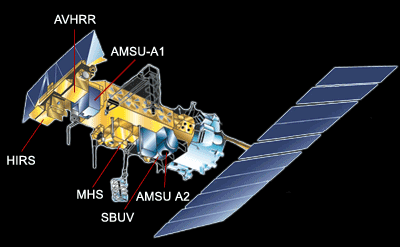For decades, the Polar Operational Environmental Satellites (POES) constellation has been the silent guardian of our planet, circling Earth from pole to pole and providing invaluable data for weather forecasting, climate monitoring, and even search and rescue operations. Now, two of its longest-serving members, NOAA-15 and NOAA-19, are preparing for their final farewells, marking the end of a remarkable era in satellite meteorology.
NOAA has officially completed End of Life (EOL) testing activities for both satellites and will commence their decommissioning process shortly. These spacecraft have far exceeded their primary mission design lives, serving as workhorses for environmental data collection well beyond expectations. As a testament to their longevity, all have incurred significant subsystem and instrument degradation or failures, entering a “twilight phase” where critical failures are increasingly likely. This transition follows the decommissioning of NOAA-18 on June 6, 2025, due to an unrecoverable S-Band transmitter failure. NOAA-15 is scheduled for decommissioning on August 12, 2025, with NOAA-19 following a week later on August 19, 2025.

The Enduring Legacy of the POES Constellation NOAA-19
The POES constellation, a joint effort between NOAA and the European Organisation for the Exploitation of Meteorological Satellites (EUMETSAT), is designed to provide daily global coverage, with each satellite making approximately 14 nearly polar orbits per day. This allows for at least two complete views of any location on Earth every 12 hours. The data from POES satellites have been instrumental for a wide array of applications, from improving severe weather forecasts (hurricanes, tornadoes, blizzards) to monitoring sea surface temperatures, atmospheric temperature and humidity profiles, and even tracking global ozone levels. Their contribution to the Cospas-Sarsat international search and rescue program has directly saved countless lives by detecting distress signals from emergency beacons.
NOAA-15: A Pioneer’s Remarkable Journey
Launched on May 13, 1998, NOAA-15 (originally NOAA-K) was the first of the fifth generation of POES satellites and was designed for a primary mission life of about two years. Yet, it diligently served for over 27 years, defying expectations. Positioned for a “morning mission” (an afternoon equator-crossing orbit after launch), NOAA-15 carried a suite of advanced instruments. Key among these were the Advanced Very High Resolution Radiometer/3 (AVHRR/3) for imaging and measuring Earth’s surface and clouds, the High Resolution Infrared Radiation Sounder/3 (HIRS/3) for atmospheric temperature and moisture profiles, and the Advanced Microwave Sounding Unit-A (AMSU-A) for similar atmospheric soundings, especially in cloudy regions.
It also included the Search and Rescue Satellite-Aided Tracking System (S&RSAT) and the Space Environment Monitor-2 (SEM-2), providing crucial data on space weather and particle flux. Despite numerous degradations to its instruments over the years, NOAA-15 continued to provide valuable data, albeit on a limited basis.
NOAA-19: The Constellation’s Enduring Workhorse
NOAA-19 (known as NOAA-N Prime before launch) was the final satellite in the POES series, launched on February 6, 2009. Like its predecessor, NOAA-19 significantly outlived its design life, operating for over 16 years. It served as the primary “afternoon mission” satellite, complementing the morning orbiters to ensure comprehensive global coverage.
NOAA-19 carried an instrument payload similar to NOAA-15, including the AVHRR/3, AMSU-A, and a more advanced High Resolution Infrared Radiation Sounder/4 (HIRS/4), along with the Microwave Humidity Sounder (MHS) for improved humidity profiles. Its continued operation was vital for collecting critical environmental data, particularly for short- and medium-term weather forecasts and supporting the international search and rescue efforts.
The Dawn of a New Era: The Joint Polar Satellite System (JPSS) NOAA-19
The decommissioning of these venerable satellites is not a step backward but a planned transition to the next generation of polar-orbiting environmental satellites: the Joint Polar Satellite System (JPSS). This collaborative program between NOAA and NASA is designed to provide continuity of critical global observations through 2038.
The JPSS constellation, which already includes the Suomi National Polar-orbiting Partnership (Suomi NPP) as a bridge mission, and operational satellites like NOAA-20 (formerly JPSS-1) and NOAA-21 (formerly JPSS-2), features advanced instruments that enhance our ability to forecast severe weather events days in advance and assess environmental hazards like droughts, wildfires, and poor air quality. Upcoming satellites like JPSS-3 and JPSS-4 will further strengthen this vital observing system.
The decommissioning of NOAA-15 and NOAA-19 marks the dignified retirement of satellites that have served humanity faithfully for far longer than intended. Their long tenure provided an unbroken stream of critical environmental data, showcasing the incredible engineering and dedication behind space-based observations. As they fade into history, the advanced JPSS constellation is poised to continue their legacy, ensuring that scientists and forecasters have the most accurate and timely information to protect lives and property for years to come.
Sources:
- NOAA-15 – NASA – NSSDCA – Spacecraft – Details
- Satellite: NOAA-15 – WMO OSCAR
- NOAA-15 – Wikipedia
- NOAA-19 (NOAA-N) – NASA’s Earth Observing System
- NOAA-19 Satellite Mission Summary | CEOS Database
- NOAA-19 – Wikipedia
